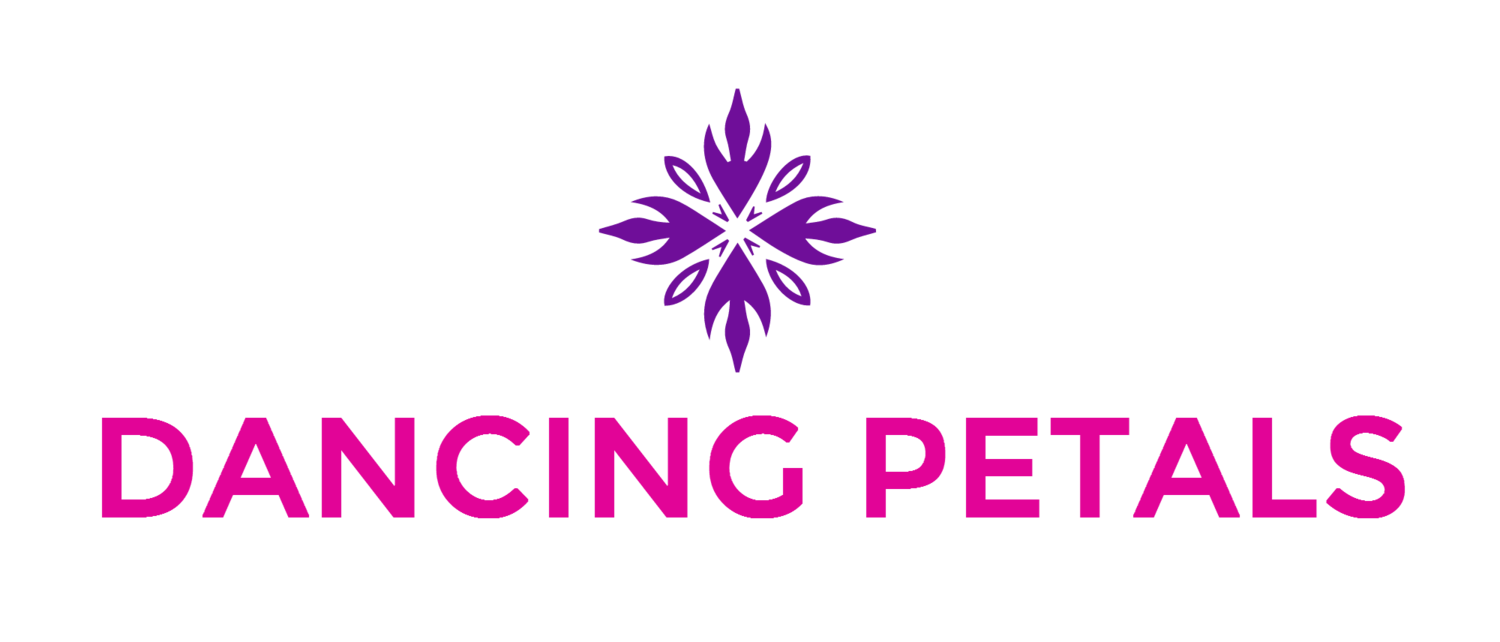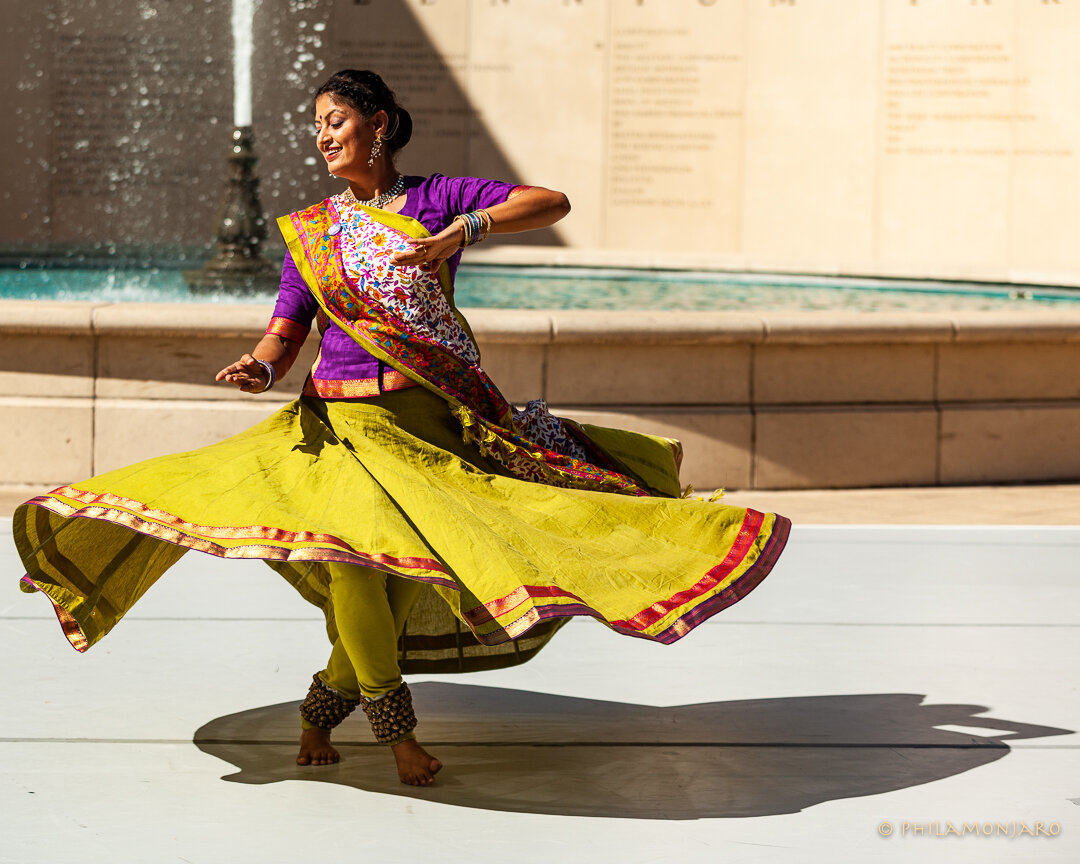2019 Chicago Summer Dance
KATHAK: an Indian Classical Dance form, is the culmination of years of varied cultural influences on the art that emanated from the story-tellers of the ancient temples. The name Kathak is derived from the Sanskrit word ‘kathā’ meaning story.
Kathak contains traces of temple and ritual dances, along with certain features of Persian and Central Asian dances. Intricate footwork and spins, as well as abhinaya, the art of expression, are the highlights of Kathak.
Kathak Costume: The typical costumes and jewelry worn by a Kathak dancer reflect the cultural origin and influences on this ancient art-form. A Kathak dancer traditionally wears either a Hindu or a Muslim inspired costume.
Hindu costume maybe a sāree with the pallav taken around the waist or a ghāghra with choli and ordhni. Latter comprises of a full length skirt with a fitting top/ blouse and a light scarf. Jewelry may include bangles, armlets, necklaces, dangling earrings and a jeweled tikā in the middle of the forehead. An ornate belt may be worn.
The Hindu costume for men is a silk dhoti with a silk scarf tied round the waist. The upper body is either left bare or covered with a vest/ jacket known as bandi. Gilt jewelry in traditional patterns mounted on cloth maybe worn around waist and arms along with necklace.
The Muslim inspired costume in vogue was introduced much later. This includes angarakhā or a kalidār kurtā, a long frock with flares. Along with this chudidār pajama or tight pants are worn on legs and an ordhni, a light scarf, is used to decorate the ensemble. The kurta may be embellished with a fitted jacket. Jewelry includes bangles, armlets, necklace, dangling earrings and a fan-shaped jhumar/ chapkā, decorating side of the head. An ornate belt may be worn. The Muslim costume for men are a flowing top and long pants. This is similar to chudidār pajama and kurtā concept.
Namaskār: is done before starting and at the end of a dance practice and presentation showing respect to God, Guru, Musicians, Stage, and the Audience. This is a symbolic way of seeking their blessings and permission.
Ghungru: Metal bells tied on a cotton cord, worn around the ankles by the dancer. These are the primary instrument of a Kathak dancer and should be respected and taken care of by the dancer
Warm-Up: Before starting a dance practice and presentation a dancer must warm-up. Warm-up may comprise of simple exercises that get the body and mind ready for movement. The main purpose of warm-up is to increase the heart-rate and get the blood flowing.
After gradual pulse raisers like walking then jogging, some joint mobilizers and dynamic stretches (short hold) are recommended. For example point and flex feet and rotate ankles; press heels and bend & stretch knees; rotate hips and stretch waist (sides, forward and back, twist example with triangle pose). Rotate wrist, shoulders, arms and roll neck. Stretch, curl and uncurl fingers and move head up & down, side to side etc.
Kathak movements like Suchita and Angles Exercises assist in hand-eye coordination. Posture is extremely important to ensure safety. Focus on alignment (ankle-knee-hip and wrist-elbow-shoulder)
Cool-Down: At the end of a dance practice and presentation the dancer must cool down. Cool-down may comprise of simple stretching exercises that gets the body and mind to slow down. The main purpose is to gradually slow down and get the heart-rate and breathing back to normal. It is important to stretch the muscles, preventing one from getting injured or sore. Yoga poses like Vajrasana, child’s pose etc are highly recommended. For example - Uttanasana is an excellent stretch pose (standing forward fold) that also calms the mind.
Teentāl: is a 16 Mātrā (beat) timecycle divided into 4 Vibhāgs (divisions/ sections) of 4 beats each, 4 + 4 + 4 + 4. It has 3 Tālis, at beats numbered 1, 5 and 13. It has 1 Khāli, at beat number 9. Thekā or the tablā bol for teentāl is dhā dhin dhin dhā dhā dhin dhin dhā dhā tin tin tā tā dhin dhin dhā
Tāl: Rhythmic time-cycle that repeats again and again.
Mātrā: Beat, Unit of measuring duration of a Tāl
Vibhāg: Division or section of a Tāl
Tāli: literally: ‘clap’. Used to show the accented beat in a Tāl.
Khāli: literally: ‘empty’. A blank beat, negative accent in a Tāl.
Tablā: A percussion instrument often used as an accompaniment to Kathak dance. It is comprised of two drums.
Bol: A Bol is a sound or syllable. Helps identify and recite rhythms.
Thekā: Thekā is the Tablā bol for a Tāl that repeats again and again
Ᾱvartan: One cycle of a Tāl
Sam: The first beat of a Tāl
Tatkār: Dance syllables produced from stomping. Basic footwork for a Tāl.
Kavitt: A composition based on a poem (Kavitā). It has bols that have meaning.
Lari: A chain of footwork patterns, ends with a tihāi
Laya: Laya means tempo. Duration between beats determines Laya of a Tāl or a Tāl based composition.
Parhant: Recitation of bols of a composition indicating beats of a Tāl.
Torā: A group of bols or syllables that starts and ends on sam.
Tihāi: A rhythmic pattern that repeats three times.
Chakkar/ Pheri: literally: spin. The Chakkar in Kathak is performed on the heel.
Asamyukta Hasta: Single Hand Gestures (Ref book - Abhinaya Darpana by Nandikeshwara) for example
(1) Pataka - Flag - Palm open, fingers together
(2) Hamsasya/ Hansasya - Swan Beak - Index finger and thumb tips touch. other fingers open
(3) ArdhaChandra - Half Moon - Fingers together, thumb is separated , open
(4) Mushthi - Fist
(5) Suchi - Needle (number 1, index finger open from mushthi)
(6) Mayura - Peacock - Ring finger and thumb tip touch
Thāt – Thāt implies holding the body in a particular dance pose. The stance is held while making delicate movements with upper torso, wrist, neck, eyes and eyebrows to the background Tāl melody. Thāt is performed in Vilambit Laya.
Āmad – Āmad is a Persian word, meaning ‘entrance’. It is a Vilambit Laya composition and is composed of the basic syllables of Kathak dance, ‘tā thei tat’.
Jugalbandi – The term literally means ‘entwined twins’. It is a performance aspect that features a duet between two performers, both dancers or one dancer and one instrumentalist. It is a playful competition, and maybe extended to more than just two participants.
Gat Chāl – Gat chāl literally mean gait. It implies stylized walking while keeping tatkār feet movements. It is a Drut Laya composition.
Gat Nikās – An abstract dancing stance held while performing a Gat Chāl is called Gat Nikās.
Gat Bhāv – An extension of Gat Nikas, where a storyline is narrated with various dance gestures, expression and gait while keeping the Tāl and Laya.
Vandanā – A Vandanā is a devotional composition remembering the divine and asking for blessings.
Stuti – Literally means ‘praise’. A devotional prayer describing the divine, while asking for blessings.
Sloka – A couplet hymn in Sanskrit language written in praise of God(s). A Sloka is an invocation to get blessings and maybe presented by a dancer at the beginning of a presentation.
Bhajan – A devotional song expressing love of the divine.
Sargam – Sargam is the term used for the seven notes in Hindustani Classical Music. It is a lyrical composition using permutations and combinations of these notes set to a Tāl and Rāg*.
Tarānā – A musical composition using syllables like ‘deem’, ‘ta nome’, ‘dere na’, set to a Tāl and Rāg*. The main melody repeats with variations and elaborations.
“The most striking thing about Kathak in comparison with the other dance styles is the impression it creates of extreme subtlety.”
Reference Books and Recommended Reading
ANG KAVYA by Pt. Birju Mahārāj
ABHINAYA DARPAN by Nandikeshvara
NATYA SHASTRA by Bharat Muni
KATHAK DANCE SYLLABI by Dr Puru Dhadheech
KATHAK: The Dance of Storytellers by Rachna Ramya
BIRJU MAHARAJ: The Master Through My Eyes by Saswati Sen
MOVEMENT IN STILLS: The Dance and Life of Kumudini Lakhia by Reena Shah




